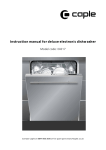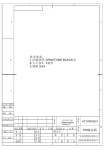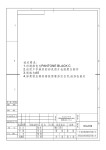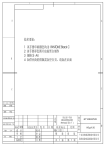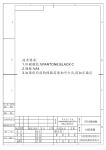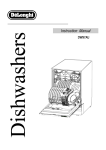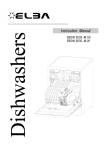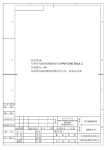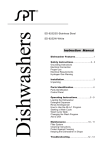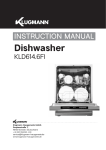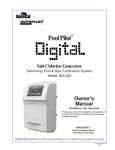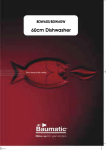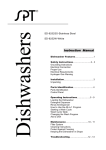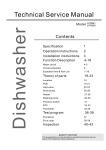Download abcabcd 日期 日 期 标准化 处数 工 艺 审 核 设 计 标记 更改文件号 审
Transcript
1 2 A B A 技术要求: 1.商标颜色为PANTONE BLACK C 其他颜色为PANTONE BLACK C 2.规格为A4 3.如果供应商的排版需要加空白页,请加在最后 B C C 借 ( 通 ) 用件登记 描 图 描 校 英文用户手册 LPR659(9347A) Prima英国 旧底图总号 底图总号 签 日 字 期 标记 处数 设 计 审 核 工 艺 标准化 1 更改文件号 签 名 校对 审定 批准 日期 日期 比例 阶段标记 REV. 02 数 量 重 量 1 共 1 张 第 1 张 6710003520 105G双铜 广东美的集团股份有限公司 美的洗涤电器制造有限公司 2 D LPR659 Dear Customer, This appliance is intended to be used in household and similar applications such as: -staff kitchen areas in shops, offices and other working environments; -farm houses; -by clients in hotels, motels and other residential type environments; -bed and breakfast type environments. Please carefully read this manual before using the dishwasher, it will help you to use and maintain the dishwasher properly. Keep it to refer to it at a later date. Pass it on to any subsequent owner of the appliance. This manual contains sections on safety Instructions, Operating Instructions, Installation Instructions and Troubleshooting Tips, etc. Control Panel...................................................3 Dishwasher Features............................ ......... ...3 A、Water Softener...........................................4 B、Loading the Salt into the Softener........... . ......5 C、Fill the Rinse Aid Dispenser................. . ........5 D、Function of Detergent ........................ ..........7 How to use the 3IN1 program............. ....... .. . ..... 9 Attention before or after loading the Dishwasher Baskets..........................................................10 Loading the upper Basket.................................10 Loading the Lower Basket....................... ... .......11 Cutlery Basket........................................... ... ..12 Wash Cycle Table...........................................14 Turning on the Appliance................................15 Change the Programme...................... .............15 At the End of the Wash Cycle...................... ......15 To review the section on troubleshooting Tips will help you to solve some common problems by yourself . If you can not solve the problems by yourself , please ask for the help of professional technicians. Filtering System.............................................16 Caring for the Dishwasher...............................17 Please carefully read the installation instruction ..................................................................... 19 Aesthetic panel's dimensions and installation ....19 Tension adjustment of the door spring .............. .21 Connection of drain hoses................................... . ....21 Dishwasher installation steps...................... . ....22 Water Connection....................................... .....24 The manufacturer, following a policy of constant development and updating of the product, may make modifications without giving prior notice. Before calling for service.................................25 Error codes...................................................26 Technical information.....................................27 WARNING! When using your dishwasher, follow the precautions listed below: This appliance must be grounded. In the event of a malfunction or breakdown, grounding will reduce the risk of anelectric shock by providing a path of least resistance of electric current. This appliance is equipped with a cord having an equipmentgrounding conductor and a grounding plug. The plug must be plugged into an appropriate outlet that is installed and grounded in accordance with all local codes and ordinances. Improper connection of the equipment-grounding conductor can result in the risk of an electric shock. Check with a qualified electrician or servi ce representative if you are in doubt whether the appliance is properly grounded. Do not modify the plug provided with the appliance; If i t does not fit the outlet. Have a proper outlet installed by a qualified electrician. Do not abuse, sit on, or stand on the door or dish rack of the dishwasher. Do not touch the heating element during or immediately after use. (This instruction is only applicable to machines with a visual heating element.) Do not operate your dishwasher unless all enclosure panels are properly in place. Open the door very carefully if the dishwasher is operating, there is a risk of water squirti ng out. Do not place any heavy objects on or stand on the door when it is open. The appliance could tip forward. When loading items to be w ashed: 1) Locate sharp items so that they are not likely to damage the door seal; 2) Warning: Knives and other utensils with sharp points must be loaded in the basket with their points down or placed in a horizontal position. When using your dishwasher, you should prevent plastic items from coming into contact with the heating element.(This instruction is only applicable to machines with a visual heating element.) Check that the detergent comparment is empty after completion of the wash cycle. Do not wash plastic items unless they are marked dishwasher safe or the equivalent. For plastic items not so marked, check the manufacturer's recommendations. Use only detergent and rinse additives designed for an automatic dishwasher. Never use soap, laundry detergent, or hand washing detergent in your dishwasher. Keep these products out of the reach of children. Keep children away from detergent and rinse aid, keep children away from the open door of the dishwasher, there could still be some detergent left inside. This appliance is not intended for use by persons (including children )with reduced physical, sensory or mental capabilities, or lack of experience and knowledge ,unless they have been given supervision or instruction concerning use of the appliance by a person responsible for their safety. Children should be supervised to ensure that they do not play with the appliance. Dishwasher detergents are strongly alkaline, they can be extremely dangerous if swallowed. Avoid contact with skin and eyes and keep children away from the dishwasher when the door is open. The door should not be left open, since this could increase the risk of tripping. If the supply cord is damaged, it must be repl aced by the manufacturer or its service agent or a similarly qualified person in order to avoid a hazard. Remove the door to the washing compartment when removing an old dishwasher from service or discarding it. Please dispose of packing materials properly. Use the dishwasher only for its intended function. During installation, the power supply must not be excessively or dangerously bent or flattened. Do not tamper with controls. The appliance is to be connected to the water mai ns using new hose sets and that old hose-sets should not be reused. The maximum number of place settings to be washed is 8. The maximum permissible inlet water pressure is 1MP a. The minimum permissible inlet water pressure is 0.04MPa. 1 Dispose of the dishwasher packaging material correctly. All packaging materials can be recycled. Plastic parts are marked with the standard international abbreviations: PE for polyethylene, e.g. sheet wrapping material PS for polystyrene, e.g. padding material POM PP ABS polyoxymethylene, e.g. plastic clips polypropylene, e.g. Salt filler Acrylonitrile Butadiene Styrene, e.g. Control Panel . WARNING! Packaging material could be dangerous for children! For disposing of package and the appliance please go to a recycling centre. Therefore cut off the power supply cable and make the door closing device unusable. Cardboard packaging is manufactured from recycled paper and should be dis posed in the waste paper collection for recycling. By ensuring this product is disposed of correctly, you will help prevent potential negative consequences for the environment and human health, which could otherwise be caused by inappropriate waste handling of this product. For more detailed information about recycling of this product, please contact your local city office and your household waste disposal service. DISPOSAL: Do not dispose this product as unsorted municipal waste. Collec tion of such waste separately for special treatment is necessary. 2 To get the best performance from your dishwasher, read all operating instructions before using it for the first time. O FF ON DE LAY 3 2 ON/OFF Button: To turn on/off the power supply. 2 Power on light: To come on when Power ON/OFF button is pressed down. 3 Delayed Start Button: Press this button to set the delayed hours for washing. You can delay the start of washi ng up to 24 hours. One press on this button delays the start of washing by one hour. PROG. 4 5 4 Display Window: delay time, running indicator, faut codes and etc. 5 Program Key-press:To select washing program when press the Key-p ress. Back View Front view 7 1 2 3 8 4 5 9 6 10 11 12 on Of f 1 2 3 Upper Basket Spray Arms Lower Basket 4 5 6 Salt Container Main Filter Detergent Dispenser 3 7 8 9 Cup Shelf Cutlery Basket Coarse Filter 10 11 12 Rinse Aid Dispenser Drain pipe connector Inlet pipe connector Before using your dishwasher for the first time: A. Set the water softener B. Pour 1/2 litre of water inside the salt container and then fill with dishwas her salt C. Fill the rinse aid dispenser D. Fill in detergent The water softener must be set manually, using the water hardness dial. The water softener is designed to remove minerals and salts from the water, which would have a detrimental or adverse effect on the operation of the appliance. The higher the content of these minerals and salts, the harder your water is. The softener should be adjusted according to the hardness of the water in your area. Your local Water Authority can advise you on the hardness of the water in your area. Adjusting Salt Consumption The dishwasher is designed to allow for adjustment in the amount of salt consumed based on the hardness of the water used. This is intended to optimise and customise the level o f salt consumption. Please follow the steps below for adjustment in salt consumption. 1. Unscrew the cap from the salt container. 2. There is a ring on the container with an arrow on it (see figure on the side), if necessary, rotate the ring in the anticlockwise direction from the "-" Setting toward the "+" sign, based on the hardness of the water being used. It is recommended that adjustments should be made in accordance with the following scheme: WATER HARDNESS dH fH Clarke mmol/l Selector Position Salt consumption (gram/cycle) Auto nomy (cycles/1kgs) 0~8 0~14 0~10 0~1.4 / 0 / 8~22 14~39 10~28 1.4~3.9 - 20 50 22~45 39~80 28~56 3.9~8 Mid 40 25 8~11 + 60 16 45~60 Note:1 80~107 °dH=1.25 °Clarke=1.78 °DH: German degree ° fH: French degree 56~75 Note:2 °fH=0.178mmol/l "/" "-" "+" "Mid" ° Clark: British degree No salt need added Setting toward the"-" sign Setting toward the"+" sign Setting toward between the "-" sign and "+" sign Contact your local water board for information on the hardness of your water supply. If your model does not have any water softener, you may skip this section. WATER SOFTENER The hardness of the water varies from place to place. If hard water is used in the dishwasher, deposits will form on the dishes and utensils. The appliance is equipped with a special softener that uses a salt container specifically designed to eliminate lime and minerals from the water. 4 Always use the salt intended for use with dishwasher. The salt container is located beneath the lower basket and should be filled as explained in the foll owing: Attention! Only use salt specif ically de signed for the use in dishwashers! Every othe r type of salt not specifically designed for the use in a dishwasher, espe cially t able sa lt, will damage the water softe ner. I n cas e of da ma ges caused by the use of unsuitable salt the manufacture r does not giv e any warranty nor is liable for any damages caused. Only fill with salt jus t before starting one of the com plete washing progra ms . This will prevent a ny grai ns of salt or salty water, which m ay have been spil led, rem aining on the bottom of the machine for any period of time, which may cause corros ion. A Remove the lower basket and then unscrew and remove the cap from the salt container. B Before the first wash, fill 1lt. of water in the salt container of your machine. C Place the end of the funnel (supplied) into the hole and introduce about 1kg of salt. It is normal for a small amount of water to come out of the salt container. D After filling the container , screw the cap tightly back clockwise. E Usually, the salt warning light will stop being illuminated within 2-6 days after the salt container has been filled with salt. F Immediately after filling the salt into the salt container, a washing program should be started Otherwise the filter system, pump or other important parts of the machine may be damaged by salty water. This is out of warranty. 1. The salt container must only be refilled when the salt warning light in the control panel comes on. Depending on how well the salt dissolves, the salt warning light may still b e on even though the salt container is filled. If there is no salt warning light in the control panel (for some Models),you can estimate when to fill the salt into the softener by the cycles that the dishwasher has run. 2. If there are spills of the salt, a soak or a rapid program should be run to remove the excessive salt. Rinse Aid Dispenser The rinse aid is released during the final rinse to prevent water from forming droplets on your dishes, which can leave spots and streaks. It also improves drying by allowing water to roll off the dishes. Your dishwasher is designed to use liquid rinse aids. The rinse aid dispenser is located inside the door next to the detergent dispenser. To fill the dispenser, open the cap and pour the rinse aid into the dispenser until the level indicator turns completely black. The volume of the rinse aid container is about 110ml. Function of Rinse Aid Rinse aid is automatically added during the last rinse, ensuring thorough rinsing, and spot and streak free drying. Attention! Only use branded rinse aid for dishwasher. Never fill the rinse aid dispenser with any other substances (e.g. Dishwasher cleaning agent, liquid detergent). This would damage the appliance. 5 When to Refill the Rinse Aid Dispenser If there is no rinse-aid warning light in the control panel, you can judge the amount of rinse-aid by the color of the optical level indicator "C" located next to the cap. When the rinse-aid container is full, the whole indicator will be dark .As the rinse-aid diminishes, the size of the dark dot decreases. You should never let the rinse aid get below 1 / 4 full. As the rinse aid diminishes, the size of the black dot on the rinse aid level indicator changes, as illustrated below. Full 3 / 4 full 1 / 2 full 1 / 4 full - Should refill to eliminate spotting Empty RINSE AID DISPENSER 1 2 3 To open the dispenser, turn the cap to the "open" (left) arrow and lift it out. Pour the rinse aid into the dispenser, being careful not to overfill. Replace the cap by inserting it aligned with "open" arrow and turning it to the closed (right) arrow. Be careful not to overfill the dispenser, because this could cause over sudsing. Wipe away any spills with a damp cloth. Don't forget to replace the cap before you close dishwasher door. Attention! Clean up any rinse aid split during filling with an absorbent cloth to avoid excess foaming during the next wash. Adjusting Rinse Aid Dispenser The rinse aid dispenser has six or four settings. Always start with the dispenser set on "4". If spots and poor drying are a problem, increase the amount of rinse aid dispensed by removing the dispenser lid and rotating the dial to "5". If the dishes still are not drying properly or are show spots, adjust the dial to the next higher lever until your dishes are spot-free. The recommended setting is "4". (Factory value is "4".) NOTE: Increase the dose if there are drops of water or lime spots on the dishes after washing. Reduce it if there are sticky whitish stains on your dishes or a bluish film on glassware or knife blades. 6 Detergents with its chemical ingredients are necessary to remove dirt, crush dirt and transport it out of the dishwasher. Most of the commercial quality detergents are suitable for this purpose. Concentrated Detergent Based on their chemical composition, detergents can be split in two basic types: conventional, alkaline detergents with caustic components low alkaline concentrated detergents with natural enzymes Detergent Tablets Detergent tablets of different brands dissolve at different speeds. For this reason some detergent tablets cannot dissolve and develop their full cleaning power during short programs. Therefore please use long programs when using detergent tablets, to ensure the complete removal of detergent residuals. Detergent Dispenser The dispenser must be refilled before the start of each wash cycle following the instructions provided in the wash cycle table . Your dishwasher uses less detergent and rinse aid than Conventional dishwasher. Generally, only one tablespoon of detergent is needed for a normal wash load. More heavily soiled items need more detergent. Always add the detergent just before starting the dishwasher, otherwise it could get damp and will not dissolve properly. Amount of Detergent to Use If the lid is closed: press release button. The lid will spring open. Always add the detergent just before starting each wash cycle. Only use branded detergent aid for dishwasher. WARNING! Dishwasher detergent is corrosive! Take care to keep it out of reach of children. Proper Use of Detergent Use only detergent specifically made for the use in dishwashers. Keep your detergent fresh and dry. Don't put powdered detergent into the dispenser until you're ready to wash dishes. 7 Fill in detergent Fill the detergent dispenser with detergent. The marki ng indicates the dosing levels , as illustrated on the right: A The place of main wash cycle detergent placed , “MIN”means approximately 20g of detergent. B The place of pre-wash cycle detergent placed , approximately 5g of detergent Please observe the manufacturers dosing and storage recommendations as stated on the detergent packaging. Close the lid and press until it locks in place. If the dishes are heavily soiled, place an additional detergent dose in the pre-wash detergent chamber. This detergent will take effect during the pre-wash phase. NOTE: You find information about the amount of detergent for the single programm es on the last page. Please aware, that according to the level soiling and the specific hardness of water differences are possible. Please observe the manufacturer's recommendations on the detergent packaging. Detergents There are 3 sorts of detergents 1.With phosphate and with chlorine 2.With phosphate and without chlorine 3.Without phosphate and without chlorine Normally new pulverised detergent is without phosphate. Thus the water softener function of phosphate is not given. In this case w e recommend to fill salt in the salt container even when the hardness of water is only 6 °dH. If detergents without phosphate are use d in the case of hard water often white spots appear on dishes and glasses. In this case please add more detergent to reach better results. Detergents without chl orine do only bleach a little. Strong and coloured spots will not be removed completely. In this case please choose a program with a higher temperature. Attention Keep all detergents in a safe place out of children's reach. Always add the detergent in the dispenser just before starting the dishwasher. 8 How To Use The 3IN1 Function Your dishwasher has a 3in1 function which needs no salt and rinse aid but a 3In1 tablet. This dishwasher comes with a 3in1 tablet container as an accessory. Only the 3in1 function(for the program: intensive/Normal/Eco.) Can be used with 3in1 tablets. If you use 3in1 tablets in other programs, the appliance will not achieve a good performance. 1. The figure below shows how to hang the 3in1 tablet container on the upper basket. 2. Rotate the upper sprayer and change the location of the container to ensure the upper sprayer is not obstructed by the 3in 1 tablet container. Refer to the figure below for reference. 3. Put the 3in1 tablet into the container ,then start the 3in1 program. When using 3in1 combination / compact Detergents ,please pay attention to make sure that the size of the combination detergents fits to the dispenser,so that combination detergents can be easily put into the dispenser, and the dispenser would not be broken. 9 For best performance of the dishwasher, follow these loading guidelines. Features and appearance of baskets and cutlery baskets may vary from your model. Attention before or after Loading the Dishwasher Baskets Scrape off any large amounts of leftover food. Soften remnants of burnt food in pans. It is not necessary to rinse the dishes under running water. Place objects in the dishwasher in following way: 1.Items such as cups, glasses, pots/pans, etc. are faced downwards. 2.Curved items, or ones with recesses, should be loaded aslant so that wate r can run off. 3.All utensils are stacked securely and can not tip over. 4.All utensils are placed in the way that the spray arms can rotate freely during washing. Very small items should not be washed in the dishwasher as they could easily fall out of the baskets. Removing the Dishes To prevent water dripping from the upper basket into the lower back, we recommend that you empty the lower basket first and then the upper basket. Loading the Upper Basket The upper basket is designed to hold more delicate and lighter dishware such as glasses, coffee and tea cup and saucers, as well as plates, small bowls and shallow pans (as long as they are not too dirty). Position the dishes and cookware so that they do not get moved by the spray of water. 1 1 2 3 4 5 6 2 6 3 5 Cups Small serving bowl Large serving bowl Glasses Saucers Dish 4 Adjusting the Upper Basket The height of the upper basket can be adjusted in order to create more space for large utensils both for the upper/lower basket. The height of the upper basket can be adjusted by placing the wheels on different height of the rails. Long items, serving cutlery, salad servers and knives should be placed on the shelf so that they do not obstruct the rotation of the spray arms. The shelf can be folded back or be removed when not required for use. Upper wheels Lower wheels 10 Loading the Lower Basket We recommend that you place large items which are most difficult to clean in to the low er basket: pots, pans, lids, serving dishes and bowls, as shown in the figure to the right. It is preferable to place serving dishes and lids on the side of the racks in order to avoi d blocking the rotation of the top spray arm. Pots, serving bowls, etc. must always be placed top down. Deep pots should be slanted to allow w ater to flow out. The bottom basket feature fold down tine rows so that larger or more pots and pans can be loaded. 1 4 3 2 1 2 3 4 5 5 4 Folding spikes For better stacking of pots and pans, the spikes can be folded down as show in the picture right. 11 Oval platter Dinner plates Soup plates Dessert dishes Silverware basket Cutlery Basket Cutlery should be placed in the cutlery basket with the handles at the bottom. If the rack has side baskets, the spoons should be loaded separately into the appropriate slots, especially long utensils should be placed in the horizontal position at the front of the upper basket as shown in the picture. 1 1 1 4 4 4 5 2 5 5 2 1 1 4 7 8 1 4 4 4 5 2 5 5 2 1 2 3 4 4 5 2 3 5 3 3 2 Forks Soup spoons Dessert spoons Teaspoons 1 3 3 2 1 3 3 6 3 6 2 5 6 7 8 Knife Serving spoon Gravy ladle Serving fork Do not let any item extend through bottom. For washing in the dishwasher the following cutlery/dishes Are of limited suitability Are not suitable Some types of glasses can become dull after a large number of washes Cutlery with wooden, horn china or mother-of-pearl handles Plastic items that are not heat resistant Older cutlery with glued parts that are not temperature resistant Bonded cutlery items or dishes Pewter or cooper items Crystal glass Steel items subject to rusting Wooden platters Items made from synthetic fibres Silver and aluminum parts have a tendency to discolour during washing Glazed patterns may fade if machine washed frequently NOTE: Do not put in items that are dirty of cigarette ash, candle wax, lacquer or paint. If you buy new dishes please make sure that they are suitable for dishwashers. NOTE: Please do not overload your dishwasher. There is only space for 8 standard dishes. Do not use dish that is not suitable for dishwashers. This is important for good results and for reasonable energy consume. Loading cutlery and dishes Before loading the dishes, you should: Remove large left-over Soften remnants of burnt food in pans When loading the dishes and cutlery, please note: Dishes and cutlery must not impede the rotation of the spray arms Load hollow items such as cups, glasses, pans etc. with the opening downwards so that water cannot collect in the container or a deep base 12 Di shes and items of cutlery must not lie inside one another, or cover each othe r To avoid damage to glasses, they must not touch Load large items which are most difficult to clean into the lower rack T he upper rack is designed to hold more delicate and lighter dishware such as glasses, coffee and tea cups Attention! Long bladed knives stored in an upri ght position are a potential hazard! Long and/or sharp items of cutl ery such as carving knives must be positioned horizontally in the upper basket. Damage to glassware and other dishes Possible causes: Type of glass or manufacturing process. Chemical composition of detergent. Water temperature and duration of dishwasher programme. Suggested remedy: Use glassware or porcelain dishes that have been marked di shwasher-proof by the manufacturer Use a mild detergent that is described as kind of dishes If necessary, seek further information from detergent manufacturers. Select a programme with as low a temperature. To prevent damage, take glass and cutlery out of the di shwasher as soon as possible after the programme has ended. 13 For normally soiled loads, Use multifunctional detergent. Pre-wash pre-wash wash45 rinse68℃ drying For heaviest soiled crockery, and normally soiled pots、 pans、dishes etc with dried on soiling. 3in1 160 0.95 14.7 Pre-wash Pre -wash( 5 0℃) Wash (60 ℃) Rinse (70 ℃) Drying 4/20 g. 160 1.10 12.9 Standard daily cycle for normally soiled loads, such as pots、plates、 glasses. Pre-wash Pre-wash Wash (50 ℃) Rinse (65 ℃) Drying 4/20 g. 155 0.81 12.5 Economy For lightly soiled loads,such as plates,glasses,bowls and lightly soiled pans. Pre-wash Wash (45 ℃) Rinse (60 ℃) Drying 20 g. 105 0.65 10.2 Rinse For dishes that need to be rinsed and dried only. Wash(45℃) Rinse (70 ℃) Drying 85 0.75 7.5 For lightly soiled crockery and glass. Pre-wash wash(40℃) rinse(70℃) drying 15 g. 110 0.75 10.2 A shorter wash for lightly soiled loads and quick wash. Wash (40 ℃) Rinse (45 ℃) 15 g. 30 0.35 6.5 Strong Normal (IEC-EN 50242) Rapid The power consumpt ion of off-mode is 0 W left-on mode is 1.4 W 14 Turning on the Appliance Starting a wash cycle... 1 Draw out the lower and upper basket, load the dishes and push them back. It is commended that loading the lower basket first, than the upper one (see the section entitled “Loading the Dishwasher”). 2 Pour in the detergent (see the section entitled “Salt, Detergent and Rinse Aid”). 3 Insert the plug into the socket. The pow er supply is 220-240 VAC 50 Hz, the specification of the socket is 10 A 250 VAC. Make sure that the water supply is turned on to full pressure. PR OG. 4 Open the door,press the ON/OFF button,and the ON/OFF li ght will turn on. Pre ss the "prog. "Button to select a desired "Wash cycle".(see the section entitl ed."Wash Cycle Table".) 5 With a little force to ensure the door is properly closed. NOTE: A click could be heard when the door is closed perfectly. 6 When the washing is over, you can shut off the switch by pressing ON/OFF button. Premise: A cycle that is underway can only be modified if it has only been running for a short time. Otherwise, the detergent may have already been released, and the appliance may have already drained the wash water. If this is the case, the detergent dispenser must be refilled (see the section entitled " Loading the Detergent " ). Open the door,Press current prog. Button more than three seconds to cancel the program ,then you can change the program to the desired cycle setting (see the section entitled " Starting a wash cycl e. . . " ). Then, close the door. NOTE: If you open the door when washing, the machine will pause. When you close the door , the machine will keep on working after 10 seconds. The 7 program lights show s the state of the dishwasher: a) All program lights off --> stand by b) One of the program lights on --> pause c) One of the program lights blinking --> run NOTE: If all the lights begin to glimmer, that indicates the machine is out of order, please turn off the main power and water supply before calling a service. A forgotten dish can be added at any time before the detergent cup opens. 1 2 Open the door a little to stop the washing. 3 Load the forgotten dishes. After the spray arms stop working, you can open the door completely. 4 Close the door, the dishwasher will start running again after 10 seconds. It is dangerous to open the door when washing,because the hot water may scald you. When the working cycle has finished, the buzzer of the dishwasher will sound for 8 seconds, then stop. Turn off the appliance using the ON/OFF button, shut off the water supply and open the door of the dishwasher. Wait for a few minutes before unloading the dishwasher to avoid handl ing the di shes and utensils while they are still hot and more susceptible to breakage. They will also dry better. 15 Switch Off the Dishwasher In the digital display appears 0 (remaining programme time), only in this case the programme has ended. 1.Switch off the dishwasher by pressing the ON/OFF button. 2.Turn off the water tap! Open the door carefully. Hot dishes are sensitive to knocks. The dishes should therefore be allowed to cool down around 15 minutes before removing from the appliance. Open the dishwasher's door, leave it ajar and wait a few minutes before removing the dishes. In this way they will be cooler and the drying will be improved. Unloading the dishwasher It is normal that the dishwasher is wet inside. Empty the lower basket first and then the upper one. This will avoid water dripping from the upper Basket onto the dishes in the lower one. The filter prevents larger remnants of food or other objects from getting inside the pump. The residues may block the filter, in this case they must be removed. The filter system consists of a coarse filter, a flat (Main filter) And a microfilter (Fine filter). 1 2 1 3 Main filter Food and soil particles trapped in this filter are pulverized by a special jet on the lower spray arm and washed down the drain. 2 Coarse filter Larger items, such as pieces of bones or glass, that could clog the drain are trapped in the coarse filter. To remove an item caught in this filter, gently squeeze the taps on the top of this filter and lift it out. 3 Fine filter This filter holds soil and food residues in the sump area and prevents it from being redeposit on the dishes during a cycle. - Inspect the filters for blocking after every time the dishwasher has been used. - By unscrewing the coarse filter. you can remove the filter system. Remove any food remnants and clean the filters under running water. 1 step1:Turn the filter in anti-clockwise direction, then lift it up 2 step2:lift the Main filter up 3 step 3: lift the Fine filter up NOTE: When following this procedure from step1 to step 3, the filter system will be removed; when following it from Step 3 to Step 1, the filter system will be installed. 16 Filter assembly For best performance and results, the filter assembly must be cleaned. The filter efficiently removes food particles from the wash water, allowing it to be recycled during the cycle. For best performance and results, the filter must be cleaned regularly. For this reason, it is a good idea to remove the larger food particles trapped in the filter after each wash cycle by rinsing the semicircular fi lter and cup under running water. To remove the filter device, pull the cup handle in the upward direction. The entire filter assembly should be cleaned once a week. To clean the coarse filter and the fine filter, use a cleaning brush. Then, reassemble the filter parts as shown in the figures left and reinsert the entire assembly in the dishwasher, positioning in its seat and pressing downward. The dishwasher must never be used without the filters. Improper replacement of the filter may reduce the performance level of the appliance and damage dishes and utensils. The dishwasher must never be used without the filters. Improper replacement of the filter may reduce the performance level of the appliance and damage dishes and utensils. Cleaning the Spray Arms It is necessary to clean the spray arms regularly for hard water chemicals will clog the spray arm jets and bearings. Remove the upper spray arm To remove the upper spray arm, screw off the nut clockwise then remove the arm. Remove the lower spray arm To remove the lower spray arm, pull out the spray arm upward . Wash the arms Wash the arms in soapy and warm water and use a soft brush to clean the jets. Replace them after rinsing them thoroughly. Caring for the Dishwasher The control panel can be cleaned by using a lightly dampened cloth. After cleaning, make sure to dry it thoroughly. For the exterior, use a good appliance polish wax. Never use sharp objects, scouring pads or harsh cleaners on any part of the dishwasher. Protect Against Freezing please take frost protection measures on the dishwasher in winter. Every time after washing cycles, please operate as follows: 1.Cut off the electrical power to the dishwasher. 2.Turn off the water supply and disconnect the water inlet pipe from the water valve. 3.Drain the water from the inlet pipe and water valve. (Use a pan to catch the water) 4.Reconnect the water inlet pipe to the water valve. 5.Remove the filter at the bottom of the tub and use a sponge to soak up water in the sump. 17 To clean the edge around the door, you should use only a soft warm, damp cloth. To avoid penetration of water into the door lock and electrical components, do not use a spray cleaner of any kind. Never use a spray cleaner to clean the door panel as it may damage the door lock and electrical components. Abrasive agents or some paper towels should not be used because of the risk of scratching or leaving spots on the stainless steel surface. After every wash, turn off the water supply to the appliance and l eave the door slightly ajar so that moisture and odours are not trapped inside. When you go on holiday, it is recommend that you run a wash cycle with the dishwasher empty and then remove the plug from the socket, turn off the water supply and leave the door of the appliance slightly ajar. This will help the seals to last longer and prevent odours from forming within the appliance. Before cleaning or performing maintenance, always remove the plug from the socket. Do not run risks. If the appliance must be moved, try to keep it in the vertical position. If absolutely necessary, it can be positioned on its back. To clean the exterior and rubber parts of the dishwasher, do not use solvents or abrasive cleaning products. Rather, use only a cloth and warm soapy water. To remove spots or stains from the surface of the interior, use a cloth dampened with water and a little vinegar, or a cleaning product made specifically for dishwashers. One of the factors that cause odours to form in the dishwasher is food that remains trapped in the seals. Periodic cleaning w ith a damp sponge will prevent this from occurring. Electrical Shock Hazard Disconnect electrical power before installing dishwasher. The installation of the pipes and electrical equipments should be done by professionals. ● Failure to do so can result in death or electrical shock. Installation preparation The installation position of dishwasher should be near the existing inlet and drain hoses and power cord. One side of the cabinet sink should be chosen to facilitate the connection of drain hoses of the dishwasher. Note: please check the accompanying installation accessories(hook for aesthetic panel ,screw) 18 Please carefully read the installation instruction. ● 1 2 Illustrations of cabinet dimensions and installation position of the dishwasher Preparations should be made before moving the dishwasher to the installation place. Choose a place near the sink to facilitate the installation of inlet and drain hoses (see figure 1). If dishwasher is installed at the corner of the cabinet, there should be som e space (illustrated in figure 2) when the door is opened. 90 ° 【Figure1】 Cabinet dimensions Less than 5mm between the top of dishwasher and cabinet and the outer door aligned to cabinet. 90 ° 820mm 580mm Electrical, drain and water supply line entrances 80 100 Space between cabinet bottom and floor 450 mm Dishwasher 【Figure2】 Cabinet Minimum space when the door is opened Door of dishwasher Minimum space of 50mm ● Aesthetic panel's dimensions and installation 1 The aesthetic wooden panel could be processed according to the figure 3 15 390 418 【Figure3】 The aesthetic panel should be processed in accordance with the illustrated dimensions 38 179 175 444 19 2 Install the hook on the aesthetic wooden panel and put the hook into the slot of the outer door dishwasher(see figure 4a). After positioning of the panel , fix the panel onto the outer door by screws and bolts(See figure 4b) . Hop hook 【Figure4a】 Installation of aesthetic panel St4 countersunk head screw Lower hook 【Figure4b】 4X18 screw Cover Installation of aesthetic wooden panel Spacer for furniture door 1. Take away the cover 2. Pin up the screw 3. Get back the cover Hook for aesthetic door Outer door of dishwasher 20 Furniture door of ● Tension adjustment of the door spring The door springs are set at the factory to the proper tension for the outer door. If aesthetic wooden panel are installed, you will have to adjust the door spring tension. Rotate the adjusting screw to drive the adjustor to strain or relax the steel cable(see figure 5). Door spring tension is correct when the door remains horizontal in the fully opened position,yet rises to a close with the slight lift of a finger. rel ax 【Figure5】 Tension adjustment of the door spring ● Connection of drain hoses Insert the drain hose into a drain pipe with a minimum diameter of 4cm, or let it run into the sink, making sure to avoid bending or crimping it. Use the speical plastic support that comes with the appliance (figure 6). The free and of the hose must be at a height between 400 and 1000mm and must not be immersed in water to avoid the back flow of it.ATTENTION: The special plastic hose support must be solidly fastened to the wall to prevent the drain hose from moving and allowing water to spill outside the drain. 【Figure6】 Drain pipe connection Drain hose hook Close the drain hose hook to the counter Front NOTE The top of the hose must be at a height between 40 and 100cm. The free end of the hose must not be immersed in water. Counter A B C Drain pipe φ 40mm 21 ● Dishwasher installation steps 1 Install the furniture door to the outer door of the dishwasher using the brackets provided. Refer to the template for positioning of the brackets. 2 Adjust the tension of the door springs by using an Allen key turning in a clockwise motion to tighten the left and right door springs. Failure to do this could cause damage to your dishwasher (Illustration 2) . 3 Connect the inlet hose to the cold water supply . 4 Connect the drain hose. Refer to diagram . (Figure 6) 5 Connect the power cord . 6 Affix the condensation strip under the work surface of cabinet. Please ensure the condensation strip is flush with edge of work surface. 7 Place the dishwasher into position. 8 Level the dishwasher. The rear feet can be adjusted from the front of the dishwasher by turning the screws on the left and right hand side of the cabinet (Illustration 5A). To adjust the front feet, use a wrench and turn the front feet until the dishwasher is level (Illustration 5B). 9 The dishwasher must be secured in place. There are two ways to do this: A. Normal work surface-secure to the work surface by using two woodscrews ensuring the dishwasher weight is not being hit by the surface (Illustration 6). B. Marble or granite work top-secure the bracket to the side panel of the dishwasher and secure the dishwasher to the furniture housing. Put the rubber cap over the screw (Illustration 7). 2 6 1 4 SCREW CONE GEAR 5A 5B 5 RUBBER COVER 7 SCREW 【Figure 7】 22 Dishwasher must be level for proper dish rack operation and wash performance. 1 Place level on door and rack track inside the tub as shown to check that the dishwasher is level. 2 level the dishwasher by adjusting the four leveling legs individually. 3 When level the dishwasher, pl ea s e pay attention not to let the dishwasher tip over. 【Figure 8】 Illustration of feet adjustment Check Level Front to Back NOTE: The maximum adjustment height of the feet is 60 mm. Check level side to side WARNING! For personal safety: DO NOT USE AN EXTENSION CORD OR AN ADAPTER PLUG WITH THIS APPLIANCE. DO NOT, UNDER ANY CIRCUMSTANCES, CUT OR REMOVE THE EARTHING CONNECTION FROM THE POWER CORD. Please look at the rating label to know the rating voltage and connect the dishwasher to the appropriate power suppl y. Use the required fuse 10 amp, time delay fuse or circuit breaker recommended and provide separate circuit serving only this appliance. Ensure the voltage and frequency of the power being corresponds to those on the rating plate. Only insert the plug into an electrical socket which is earthed properly. If the electrical socket to which the appliance must be connected is not appropriate for the plug , replace the socket, rather than using a adaptors or the like as they could cause overheating and burns. This appliance must be earthed. In the event of a malfunction or breakdown, earthing will reduce the risk of electric shock by providing a path of least resistance for the electric current. This appliance is equipped with a cord having an equipment-earthing conductor and an earthing plug. The plug must be plugged into an appropriate outlet that is install ed and earthed in accordance with all local standards and requirements. 23 Improper connection of the equipment- grounding conductor can result in the risk of an electric shock. Check with a qualified electrician or service representative if you are in doubt whether the appl iance is properly grounded. Do not modify the plug provided wit h the appliance; If it is not fit for the out let. Have a proper outlet installed by a qualified electrician. Please close the hydrant after using. Connect the cold water supply hose to a threaded 3/4(inch) connector and make sure that it is fastened tightly in place. If the water pipes are new or have not been used for an extended period of time, let the water run to make sure that the water is clear. This precaution is needed to avoid the risk of the water inlet to be blocked and damage the appliance. Positioning the Appliance Position the appliance in the desired location. The back should rest against the wall behind it, and the sides, along the adjacent cabinets or walls. The dishwasher is equipped with water supply and drain hoses that can be positioned either to the right or the left sides to facilitate proper installation. How to Drain Excess Water From Hoses If the sink is 1000 higher from the floor, the excess water in hoses cannot be drained directly into the sink. It will be necessary to drain excess water from hoses into a bowl or suitabl e container that is held outside and lower than the sink. Water Outlet Connect the water drain hose. The drain hose must be correctly fitted to avoid water leaks. Ensure that the water drain hose is not kinked or squashed. Extension Hose If you need a drain hose extension, make sure to use a similar drain hose. It must be no longer than 4 metres; otherwise the cleaning effect of the dishwasher could be reduced. Syphon Connection The waste connection must be at a height of between 40 cm (minimum) and 100 cm (maximum) from the bottom of the dish. The water drain hose should be fixed by a hose cli p. The free end of the hose must not be immersed in water. The following things should be checked before starting the dishwasher. 1 The dishwasher is level and fixed properly 2 The inlet valve is open 3 There is a leakage at the connections of the conducts 4 The wires are tightly connected 5 The power is switched on 6 The inlet and drain hoses are knotted 7 All packing materials and printings should be taken out from the dishwasher After installation, please make sure to keep this manual. The content of this manual is very helpful to the users. 24 Technical problems General problems Fuse blown, or the circuit breaker acted Replace fuse or reset circuit breaker. Remove any other appliances sharing the same circuit with the dishwasher Power supply is not turned on Make sure the dishwasher is turned on and the door is closed securely. Make sure the power cord is properly plugged into the wall socket. Error code:E1; Water pressure is low Check that the water supply is connected properly and the water is turned on. Door of dishwasher not properly closed. Make sure to close the door properly and latch it. Kink in drain hose Check drain hose. Filter clogged Check coarse the filter (see section titled " Cleaning The Filter ") Kitchen sink clogged Check the kitchen sink to make sure it is draining well. If the problem is the kitchen sink not draining ,you may need a plumber rather than a serviceman for dishwashers. Improper detergent Use only the special dishwasher detergent to avoid suds. If this occurs, open the dishwasher and let suds evaporate. Add 1 gallon of cold water to the tub. Close and latch the dishwasher, then Start the "soak" wash cycle to drain out the water . Repeat if necessary. Spilled rinse-aid Always wipe up rinse-aid spills immediately. Detergent with colourant was used Make sure that the detergent is the one without colourant. Hard water minerals To clean the interior, use a damp sponge with dishwasher detergent and wear rubber gloves. Never use any other cleaner than dishwasher detergent for the risk of foaming or suds. The affected items are not corrosion resistant. Always run the quick wash programme . A programme was not without any crockery in the dishwasher and run after dishwasher salt was added. without selecting the Turbo function (if present), after adding dishwasher salt. Traces of salt have gotten into the wash cycle. Noise The lid of the softer is loose Check the lip .Ensure the fix is fine. A spray arm is knocking against an item in a basket Interrupt the programme, and rearrange the items which are obstructing the spray arm. Items of crockery are loose in the wash cabinet Interrupt the programme, and rearrange the items of crockery. This may be caused by on-site installation or the cross-section of the piping. This has no influence on the dishwasher function. if in doubt, contact a suitably qualified plumber. 25 Unsatis -factory washing result Unsatis -factory drying result The dishes were not loaded correctly. See notes in " Loading the Dishwasher Baskets ". The programme was not powerful enough. Select a more intensive programme. See" Wash Cycle Table ". Not enough detergent was dispensed. Use more detergent, or change your detergent. Items are blocking the path of spray arms. Rearrange the items so that the spray can rotate freely. The filter combination in the base of wash cabinet is not clean or is not correctly fitted. This may cause the spray arm jets to get blocked. Clean and/or fit the filter combination correctly. Clean the spray arm jets. See "Cleaning the Spray Arms". Combination of soft water and too much detergent. Use less detergent if you have soft water and select a shortest cycle to wash the glassware and to get them clean. Aluminum utensils have rubbed against dishes. Use a mild abrasive cleaner to eliminate those marks. Dishes block detergent cups. Re-loading the dishes properly. Improper loading Load the dishwasher as suggested in the directions. Too little rinse-aid Increase the amount of rinse-aid/refill the rinse-aid dispenser. Dishes are removed too soon Do not empty your dishwasher immediately after washing. Open the door slightly so that the steam can escape. Begin unloading the dishwasher only once t he dishes are barely warm to the touch. Empty the low basket first. This prevents water form dropping off dishes in the upper basket. Wrong program has been selected In short program the washing temperature is lower. This also lowers cleaning performance. Choose a program with a long washing time. Use of cutlery w ith a low-quality coating Water drainage is more difficult with these items. Cutlery or dishes of this type are not suitable for washing in the dishwasher. Longer inlet time. WARNING! Faucets is not opened, or water intake is restricted,or water pressure is too low. Longer heating time, but not reaching required temperature Malfunction of temperature sensor or of heating element. Overfilled. Too much inlet water. . Failure of temperature sensor Open circuit or break of temperature sensor Failure of temperature sensor Short circuit or break of temperature sensor If overflow occurs, turn off the main water supply before calling a service. If there is water in the base pan because of an overfill or small leak, the water should be removed before restarting the dishwasher. 26 Height : Width : Depth : Voltage connected Load : Water pressure: Power supply: Capacity: 820mm(adjustable+60mm) 445mm 540mm see rating label 0.04-1.0MPa see rating label 8 Place settings 27 Sheet of household dishwasher according to EU Directive 1059/2010: Manufacturer PRIMA Type / Description LPR659 Standard place settings 8 Energy efficiency class A Annual energy consumption 228 kWh Energy consumption of the standard cleaning cycle 0.81 kWh Power consumption of off-mode 0W Power consumption of left-on mode 1.4 W Annual water consumption 3500 liter Dryi ng efficiency class A Standard cleaning cycle Normal 50℃ Program duration of the standard cleaning cycle 155 min Noise level 49 dB(A) re 1 pW Mounting build under Could be built-in Yes Height 82 cm Width 44.5 cm Depth (with connectors) 54 cm Power consumption 1930 W Rated voltage / frequency 220-240 V~ 50 Hz Water pressure (flow pressure) 0.4-10 bar = 0.04-1 MPa NOTE: A + + + (highest efficiency) to D (lowest efficiency) Energy consumption “228” kWh per year, based on 280 standard cleaning cycles using cold water fill and the consumption of the low power modes. Actual energy consumption will depend on how the appliance is used. Water consumption “3500”litres per year, based on 280 standard cleaning cycles. Actual water consumption will depend on how the appliance is used. A (highest efficiency) to G (lowest efficiency) This program is suitabl e for cleaning soiled normally soiled tableware and that it is the most efficient programme in terms of its combined energy and water consumption for that type of tableware. The device meets the European standards and the directives in the current version at delivery: - LVD 2006/95/EC - EMC2004/108/EC - EUP 2009/125/EC The above values have been measured in accordance with standards under specified operating conditions. Results may vary greatly according to quantity and pollution of the dishes, water hardness, amount of detergent, etc. The manual is based on the European Union's standards and rules. 28































